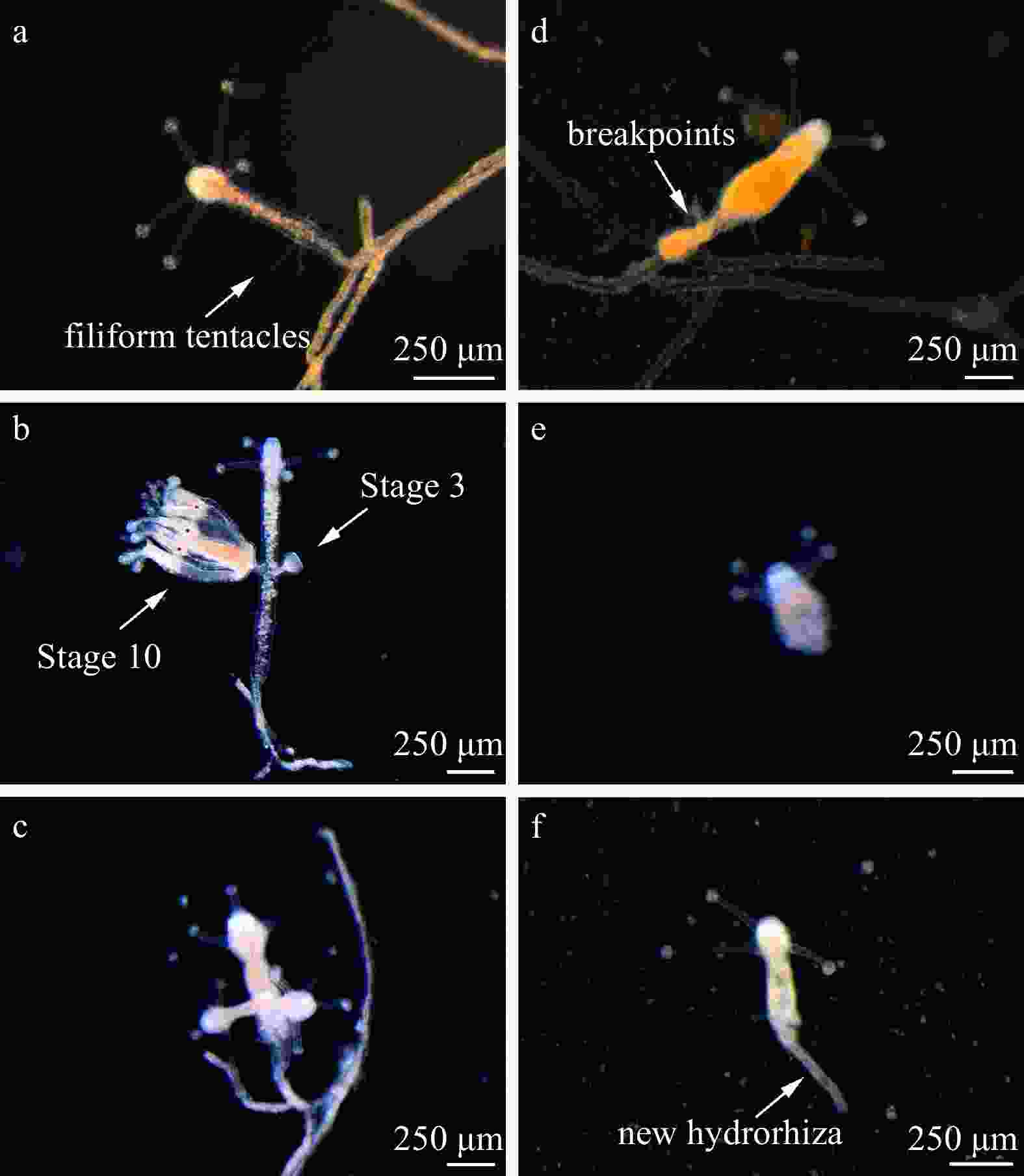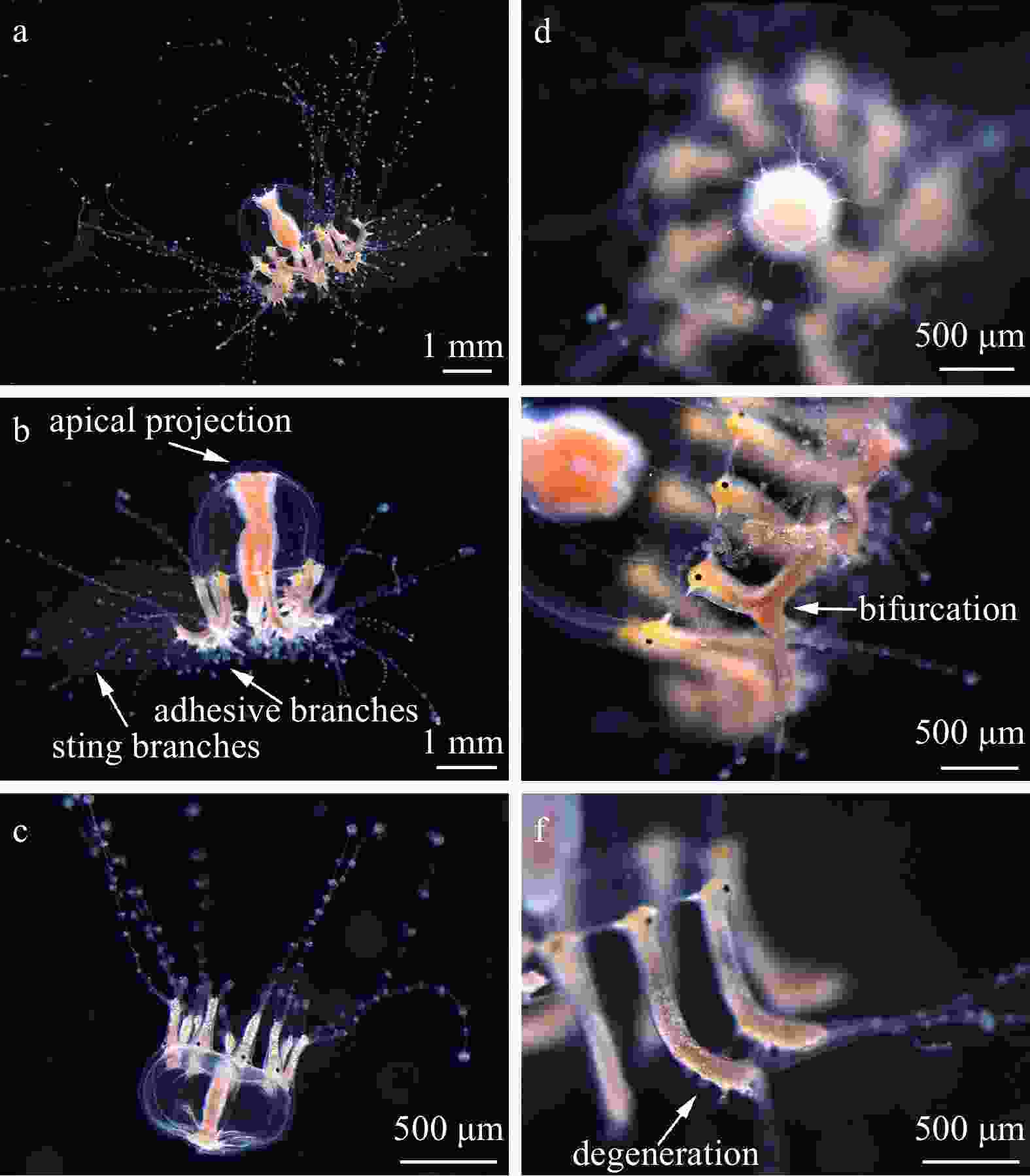Discovery of Cladonema multiramosum sp. nov. (Cnidaria: Hydrozoa: Cladonematidae) using DNA barcoding and life cycle analyses
-
Abstract: In contrast to typical planktonic hydromedusae, Cladonema medusae are mostly benthic, with specialised adhesive branches to adhere to the substrate. In this study, a Cladonema species discovered in a laboratory aquarium in Fuzhou, China, was confirmed as a new species, based on morphological and molecular analyses. The species was named Cladonema multiramosum sp. nov. Its medusa is distinct from that of congeners possessing substantially more adhesive branches (8–24, rarely 5–7), and tiny branches on the upper radial canals. The validity of C. multiramosumum sp. nov. was also supported by molecular phylogenetic analyses based on the mitochondrial 16S rDNA sequence. However, C. multiramosum sp. nov. medusa also displayed considerable phenotypic plasticity with respect to its radial canals, tentacles, stinging branches per tentacle, oral tentacles, manubrium, and gonads, hindering species identification based solely on morphology. Although some morphological characteristics of hydroids (filiform tentacles and medusa buds) and nematocysts could also be used as diagnostic characters in the genus Cladonema, this information is unavailable for some Cladonema species. Thus, the taxonomy within the genus Cladonema was re-evaluated based mainly on the morphological characteristics of the medusa. Further revision of the genus Cladonema should be made when supplementary information on the life cycle and DNA barcoding are updated.
-
Key words:
- Cladonema /
- morphology /
- life cycle /
- DNA barcoding /
- 16S rDNA
-
Figure 4. Neighbour-joining clustering of Cladonematidae based on mitochondrial 16S rDNA. Bootstrap values of 1 000 pseudoreplicates higher than 70% were shown above the branches as node-support values. The first number along the branches refers to the neighbour-joining bootstrap values, while the second number refers to the maximum likelihood bootstrap values.
Table 1. PCR primers and GenBank accession numbers of sequences used in this study
Gene Primer name Sequence (5' to 3') GenBank accession number Reference 16S 16S-L GACTGTTTACCAAAAACATA MW714350–MW714354 Ender and Schierwater (2003) 16S-H CATAATTCAACATCGAGG COI LCO-1490 GGTCAACAAATCATAAAGATATTGG MW714344–MW714348 Folmer et al. (1994) HCO-2198 TAAACTTCAGGGTGACCAAAAAATCA Table 2. Measurements (mean±SD (range)) of polyps of Cladonema multiramosum sp. nov. (n=30)
Parts Parameters Results Hydranth height/mm 0.61±0.18 (0.30–0.98) width/mm 0.08±0.02 (0.05–0.12) Oral tentacle type capitate number 4–6 length/mm 0.29±0.09 (0.15–0.45) Aboral tentacles type filiform number 4–6 Medusa buds position between oral and aboral tentacles number 1–5 Hydrocaulus length/mm 0.10±0.06 (0.03–0.22) width/mm 0.03±0.01 (0.02–0.06) Hydrorhiza width/mm 0.03±0.01 (0.02–0.06) Table 3. Measurements (mean±SD (range)) of medusae of Cladonema multiramosum sp. nov. (n=30)
Parts Parameters New released medusa Mature
medusaUmbrella height/mm 0.52±0.06 (0.40–0.69) 1.60±0.18 (1.36–1.95) diameter/mm 0.74±0.08 (0.60–0.92) 1.91±0.19 (1.57–2.26) Apical
projectionheight/mm absent 0.25±0.06 (0.13–0.39) Radial canals number 6–11 8–11 type simple straight branched Marginal tentacles number 6–11 8–11 the number of adhesive branches 1–3, mainly 1 5–24 the number of stinging branches 1 2–6 Ocelli location on bulbs on bulbs number 6–11 8–12 colour red–brown black Manubrium length/mm 0.46±0.05 (0.34–0.55) 1.50±0.34 (0.78–2.51) width/mm 0.13±0.02 (0.10–0.16) 0.64±0.16 (0.44–0.99) Oral tentacle number absent 5–8 Gonad length/mm absent 1.23±0.29 (0.62–2.03) colour absent white Table 4. Pairwise Kimura 2 Parameter (K2P) genetic distances (mean±SD (range) ) between species in family Cladonematidae based on mitochondrial 16S rDNA
Staurocladia wellingtoni Staurocladia vallentini Staurocladia oahuensis Staurocladia bilateralis Staurocladia sp. (MT709274) Eleutheria claparedii Staurocladia wellingtoni 0 Staurocladia vallentini 0.188±0.015 (0.169–0.205) 0.038 Staurocladia oahuensis 0.197±0.003 (0.195–0.201) 0.118 − Staurocladia bilateralis 0.208±0.003 (0.205–0.211) 0.121±0.012 (0.113–0.129) 0.157 − Staurocladia sp. (MT709274) 0.179±0.007 (0.172–0.186) 0.121±0.009 (0.115–0.128) 0.156 0.133 − Eleutheria claparedii 0.185±0.003 (0.183–0.189) 0.213±0.011 (0.205–0.221) 0.202673646 0.217316434 0.226 − Eleutheria dichotoma 0.196±0.008 (0.184–0.209) 0.110±0.012 (0.094–0.128) 0.132±0.005 (0.126–0.138) 0.105±0.007 (0.097–0.113) 0 0.223±0.006 (0.217–0.230) Cladonema pacificum 0.156±0.002 (0.155–0.160) 0.219±0.019 (0.196–0.242) 0.236±0.007 (0.231–0.241) 0.255±0.004 (0.252–0.257) 0.228±0.007 (0.223–0.232) 0.197±0.002 (0.195–0.198) Cladonema radiatum 0.127±0.008 (0.116–0.138) 0.198±0.013 (0.181–0.221) 0.190±0.011 (0.182–0.207) 0.216±0.007 (0.208–0.226) 0.199±0.010 (0.190–0.210) 0.192±0.010 (0.182–0.208) Cladonema sp. (AM088484) 0.242±0.003 (0.239–0.245) 0.258 0.283 0.237 0.274 0.241 Cladonema sp. (MT709261) 0.121±0.003 (0.117–0.123) 0.170±0.012 (0.162–0.178) 0.206 0.203 0.179 0.195 Cladonema multiramosum sp. nov. 0.186±0.003 (0.182–0.193) 0.195±0.006 (0.188–0.204) 0.215±0.001 (0.214–0.217) 0.219±0.002 (0.218–0.223) 0.233±0.002 (0.232–0.237) 0.231±0.001 (0.231–0.233) Eleutheria dichotoma Cladonema pacificum Cladonema radiatum Cladonema sp. (AM088484) Cladonema sp. (MT709261) Cladonema multiramosum sp. nov. Staurocladia wellingtoni Staurocladia vallentini Staurocladia oahuensis Staurocladia bilateralis Staurocladia sp. (MT709274) Eleutheria claparedii Eleutheria dichotoma 0.030±0.022 (0.002–0.051) Cladonema pacificum 0.241±0.007 (0.232–0.247) 0.002 Cladonema radiatum 0.200±0.011 (0.186–0.221) 0.128±0.006 (0.121–0.137) 0.021±0.016 (0–0.036) Cladonema sp. (AM088484) 0.291±0.002 (0.289–0.294) 0.255±0.012 (0.247–0.264) 0.274±0.013 (0.261–0.295) − Cladonema sp. (MT709261) 0.193±0.007 (0.186–0.201) 0.137±0.010 (0.131–0.144) 0.111±0.007 (0.105–0.121) 0.262 − Cladonema multiramosum sp. nov. 0.227±0.015 (0.210–0.244) 0.140±0.004 (0.136–0.145) 0.111±0.003 (0.106–0.117) 0.296±0.003 (0.294–0.300) 0.092±0.001 (0.091–0.093) 0.002±0.002 (0–0.005) Note: The pairwise intra-species K2P genetic distances were in bold. − represents absent. Table 5. Comparison of the morphology of polyps in the genus Cladonema
Species Capitate tentacles Filiform tentacles Medusae buds Reference Cladonema californicum 4 4–5 2–3, in a single whorl between capitate and filiform tentacles Rees (1979) Cladonema radiatum 4–5 4–5 1, above filiform tentacles Schuchert (2006) Cladonema myersi 4 none 1, below capitate tentacles Rees (1950) Cladonema pacificum 4–5 none 1, below capitate tentacles Hirai (1958); Rees (1982); Takeda et al. (2018) Cladonema novaezelandiae not described not described not described Ralph (1953) Cladonema timmsii not described not described not described Gershwin and Zeidler (2008) Cladonema multiramosum sp. nov. 4–6, rarely 10 4–6, rarely 10 1–5, between capitate and filiform tentacles this study Table 6. Comparison of the morphology of medusae in the genus Cladonema
Species Umbrella Radial canals Tentacles Tentacle bases Manubrium Gonads Oral tentacles Reference Height/mm Diameter/mm Apical projection No. Branch pattern No. Adhesive branches Stinging branches Ocelli Branches Cladonema californicm short than diameter 2–3 – 9, rarely 11 unbranched 9–11 1 2 1; elongated; red – beyond bell margin 6, rarely 7, elongated rounded protrusions 6 Rees (1979) Cladonema radiatum 2–4 2–3 +/– 7–11 straight or bifurcating near origin 8–10 1–4 3–10 1, red-brown, black, dark red – not extending beyond bell margin 4–6 gastric pouches, encircling upper 2/3 of the manubrium 4–7 Raghu (1961); Schuchert (1996, 2006) Cladonema myersi not described not described – 7, rarely 5–6 unbranched 7 3 7 1; reddish – half of bell cavity not described 6 Rees (1950); Rees (1982) Cladonema pacificum 2–3 2.2 – 9 straight or bifurcating near origin 9 4 3–6 1; deep purple, nearly black – extending beyond bell margin around the whole manubrium 6 Takeda et al. (2018) Cladonema novaezelandiae not described 1.5 not described 7–8 most straight and 1 branched 9 ≤7 ≤10 1 – not described 6 pouches, 6 Ralph (1953); Schuchert (1996) Cladonema timmsii 2 2 – 9 unbranched 9 5–7 6–8 1; dark red – not extending beyond bell margin female: encircling upper half of the manubrium, greatly swollen, without pouches; male: 6 radially arranged pouches 6 Gershwin and Zeidler (2008) Cladonema multiramosum sp. nov. 1.36–1.95 1.57–2.26 + 8–11 straight or bifurcating near origin; some with serval tiny branches on top 8–11 8–24, rarely 5–7 3–6 1, rarely 2; black +/– extending beyond bell margin or not around upper 1/2–1 (mean 4/5) of the manubrium 5–8 this study Note: + means present; −, absent. Table 7. Nematocysts (μm) of Cladonema species
Stage Type Cladonema multiramosum sp. nov. Cladonema radiatum Cladonema californicm Cladonema pacificum Polyp Stenoteles (10.2–18.6)×(6.5–10.9) (11–17)×(8–10) (14–18.5)×(10–12)
28×18(16.5–20)×(11.5–12)
(13–14)×8Mastigophores (11.1–14.3)×(3.3–4.7) (10–12)×(3.5–4) absent absent Medusa Stenoteles (7.5–18.5)×(4.6–11.9) (13–16)×(9–10)
(9.5–11)×(5–8.5)(21–23)×(14–16)
(14–18)×(9.5–11)(20.5–23)×(13.5–14)
(11.5–14)×(7–8)Desmonemes (6.2–9.0)×(3.3–5.1) (9–12)×(3.5–5) (9–11)×(4.5–5) (9–10)×4 Reference this study Schuchert (1996) Rees (1979) Rees (1982) -
[1] Bouillon J, Boero F, Seghers G. 1988. Notes additionelles sur les Hydroméduses de la mer de Bismarck (Hydrozoa-Cnidaria) II. Indo-Malayan Zoology, 5: 87–99 [2] Bouillon J, Gravili C, Pagès F, et al. 2006. An introduction to Hydrozoa. Memoires du Museum National d'Histoire Naturelle, 194: 591 [3] Bucklin A, Hopcroft R R, Kosobokova K N, et al. 2010a. DNA barcoding of Arctic Ocean holozooplankton for species identification and recognition. Deep-Sea Research Part II: Topical Studies in Oceanography, 57(1–2): 40–48 [4] Bucklin A, Ortman B D, Jennings R M, et al. 2010b. A “Rosetta Stone” for metazoan zooplankton: DNA barcode analysis of species diversity of the Sargasso Sea (Northwest Atlantic Ocean). Deep-Sea Research Part II: Topical Studies in Oceanography, 57(24–26): 2234–2247 [5] Cedeño-Posso C. 2014. First record of the genus Cladonema (medusae and polyps) in Colombia. Zootaxa, 3793(5): 597–599. doi: 10.11646/zootaxa.3793.5.8 [6] Ender A, Schierwater B. 2003. Placozoa are not derived cnidarians: evidence from molecular morphology. Molecular Biology and Evolution, 20(1): 130–134 [7] Farias G B, Leitão S N, De Castro Melo P A M, et al. 2020. First in situ record of the medusa stage of Cladonema radiatum (Cnidaria: Anthoathecata) in the South Atlantic Ocean. Ocean and Coastal Research, 68: e20349. doi: 10.1590/s2675-28242020068349 [8] Folmer O, Black M B, Hoeh W R, et al. 1994. DNA primers for amplification of mitochondrial cytochrome c oxidase subunit I from diverse metazoan invertebrates. Molecular Marine Biology and Biotechnology, 3(5): 294–299 [9] Fujiki A, Hou Shiting, Nakamoto A, et al. 2019. Branching pattern and morphogenesis of medusa tentacles in the jellyfish Cladonema pacificum (Hydrozoa, Cnidaria). Zoological Letters, 5(1): 12. doi: 10.1186/s40851-019-0124-4 [10] Fujita S, Kuranaga E, Nakajima Y I. 2019. Cell proliferation controls body size growth, tentacle morphogenesis, and regeneration in hydrozoan jellyfish Cladonema pacificum. PeerJ, 7: e7579. doi: 10.7717/peerj.7579 [11] Gershwin L A, Zeidler W. 2008. Cladonema timmsii, a new species of hydromedusa (Cnidaria: Hydrozoa) from a salt lake in South Australia. Zootaxa, 1826(1): 59–68. doi: 10.11646/zootaxa.1826.1.4 [12] Ghory F S, Ali Q M, Ahmed Q. 2020. First record of Cladonema radiatum Dujardin, 1843 (Hydrozoa: Cladonematidae) from northern Arabian Sea, Pakistan. International Journal of Fisheries and Aquatic Research, 5(3): 14–16 [13] Graziussi D F, Suga H, Schmid V, et al. 2012. The “Eyes absent” (eya) gene in the eye-bearing Hydrozoan Jellyfish Cladonema radiatum: conservation of the retinal determination network. Journal of Experimental Zoology Part B: Molecular and Developmental Evolution, 318(4): 257–267. doi: 10.1002/jez.b.22442 [14] Guindon S, Dufayard J F, Lefort V, et al. 2010. New algorithms and methods to estimate maximum-likelihood phylogenies: assessing the performance of PhyML 3.0. Systematic Biology, 59(3): 307–321. doi: 10.1093/sysbio/syq010 [15] He Jinru, Zheng Lianming, Zhang Wenjing, et al. 2015. Morphology and molecular analyses of a new Clytia species (Cnidaria: Hydrozoa: Campanulariidae) from the East China Sea. Journal of the Marine Biological Association of the United Kingdom, 95(2): 289–300. doi: 10.1017/S0025315414000836 [16] Hirai E. 1958. On the species of Cladonema radiatum var. mayeri Perkins. Bulletin of the Marine Biological Station of Asamushi, 9(1): 23–25 [17] Lindner A, Govindarajan A F, Migotto A E. 2011. Cryptic species, life cycles, and the phylogeny of Clytia (Cnidaria: Hydrozoa: Campanulariidae). Zootaxa, 2980(1): 23–36. doi: 10.11646/zootaxa.2980.1.2 [18] Nawrocki A M, Schuchert P, Cartwright P. 2010. Phylogenetics and evolution of Capitata (Cnidaria: Hydrozoa), and the systematics of Corynidae. Zoologica Scripta, 39(3): 290–304. doi: 10.1111/j.1463-6409.2009.00419.x [19] Östman C. 1979. Two types of nematocysts in Campanulariidae (Cnidaria, Hydrozoa) studied by light and scanning electron microscopy. Zoologica Scripta, 8(1–4): 5–12 [20] Östman C. 1982. Nematocysts and taxonomy in Laomedea, Gonothyraea and Obelia (Hydrozoa, Campanulariidae). Zoologica Scripta, 11(4): 227–241. doi: 10.1111/j.1463-6409.1982.tb00536.x [21] Östman C. 1987. New techniques and old problems in hydrozoan systematics. In: Bouillon J, Boero F, Cicogna F, et al, eds. Modern Trends in the Systematics, Ecology, and Evolution of Hydroids and Hydromedusae. Oxford: Clarendon Press, 67–82 [22] Östman C. 2000. A guideline to nematocyst nomenclature and classification, and some notes on the systematic value of nematocysts. Scientia Marina, 64(S1): 31–46. doi: 10.3989/scimar.2000.64s131 [23] Purcell J E. 2018. Successes and challenges in jellyfish ecology: examples from Aequorea spp. Marine Ecology Progress Series, 591: 7–27. doi: 10.3354/meps12213 [24] Ralph P M. 1953. A guide to the athecate (gymnoblastic) hydroids and medusae of New Zealand. Tuatara, 5(2): 59–75 [25] Raghu P R, Tampi P, Durve V. 1961. Note on the occurrence of the Anthomedusa cladonema in the Indian region. Journal of the Marine Biological Association of India, 3(1−2): 251–252 [26] Rees W J. 1950. On Cladonema myersi, a new species of hydroid from the Californian Coast. Proceedings of the Zoological Society of London, 119(4): 861–865 [27] Rees J T. 1979. The polyp and immature medusa stages of Cladonema californicum, Hyman, 1947 (Anthomedusae: Cladonemidae) with biological notes and a discussion of the taxonomy of the genus Cladonema. Journal of Natural History, 13(3): 295–302. doi: 10.1080/00222937900770231 [28] Rees J T. 1982. The hydrozoan Cladonema in California: a possible introduction from East Asia. Pacific Science, 36(4): 439–444 [29] Schuchert P. 1996. The marine fauna of New Zealand: athecate hydroids and their medusae (Cnidaria: Hydrozoa). New Zealand Oceanographic Institute Memoir, 106: 1–159 [30] Schuchert P. 2006. The European athecate hydroids and their medusae (Hydrozoa, Cnidaria): Capitata part 1. Revue suisse de Zoologie, 113(2): 325−410. [31] Schuchert P. 2016. The polyps of Oceania armata identified by DNA barcoding (Cnidaria, Hydrozoa). Zootaxa, 4175(6): 539–555. doi: 10.11646/zootaxa.4175.6.3 [32] Schuchert P. 2021. World Hydrozoa Database. Cladonema Dujardin, 1843. http://marinespecies.org/aphia.php?p=taxdetails&id=117049[2021-09-14] [33] Schuchert P, Hosia A, Leclère L. 2017. Identification of the polyp stage of three leptomedusa species using DNA barcoding. Revue Suisse de Zoologie, 124(1): 167–182 [34] Takeda N, Deguchi R, Itabashi T. 2018. Reproductive strategies in marine Hydrozoan Jellyfish: sexual medusae and asexual polyps. In: Kobayashi K, Kitano T, Iwao Y, et al, eds. Reproductive and Developmental Strategies. Tokyo: Springer, 157–174 [35] Tamura K, Peterson D, Peterson N, et al. 2011. MEGA5: molecular evolutionary genetics analysis using maximum likelihood, evolutionary distance, and maximum parsimony methods. Molecular Biology and Evolution, 28(10): 2731–2739. doi: 10.1093/molbev/msr121 [36] Xu Zhenzu. 1993. Revisions of nominal species on the Hydromedusae of China sea areas. Journal of Oceanography in Taiwan Strait, 12(3): 197–204 [37] Zheng Lianming, He Jinru, Lin Yuanshao, et al. 2014. 16S rRNA is a better choice than COI for DNA barcoding hydrozoans in the coastal waters of China. Acta Oceanologica Sinica, 33(4): 55–76. doi: 10.1007/s13131-014-0415-8 [38] Zhou Taixuan, Huang Mingxian. 1958. A study on hydromedusae of Chefoo. Acta Zoologica Sinica, 10(2): 173–197 [39] Zhou Konglin, Zheng Lianming, He Jinru, et al. 2013. Detection of a new Clytia species (Cnidaria: Hydrozoa: Campanulariidae) with DNA barcoding and life cycle analyses. Journal of the Marine Biological Association of the United Kingdom, 93(8): 2075–2088. doi: 10.1017/S0025315413000969 -





 下载:
下载:






